Looking for the best day hikes in Southeast Asia? Get ready for an adventure that’ll redefine your travel bucket list!
If you’re new to day hiking, be sure to check out Ultimate Hiking Essentials for Beginners to prepare for the journey!
The best day hikes in Southeast Asia aren’t just walks—they’re epic journeys through some of the most stunning landscapes on the planet. From volcanic craters with electric blue flames to misty mountain peaks and lush, hidden forests, this region is a treasure trove of one-day adventures waiting to be explored.
In this ultimate guide to the best day hikes in Southeast Asia, I’ve curated the absolute must-do trails designed for adventurers who want maximum experience with minimal time commitment. No multi-day treks required, just pure, concentrated adventure.
Why These Best Day Hikes in Southeast Asia Are A Must
🕒🌍 Perfect for travelers with limited time
🌋🌳 From volcanoes to rainforests
🏃♂️💪 Suitable for various fitness levels
📸🌄 Stunning views guaranteed
🏞️🌏 Close encounters with local environments
1. Mount Fansipan, Vietnam: Conquering the Roof of Indochina
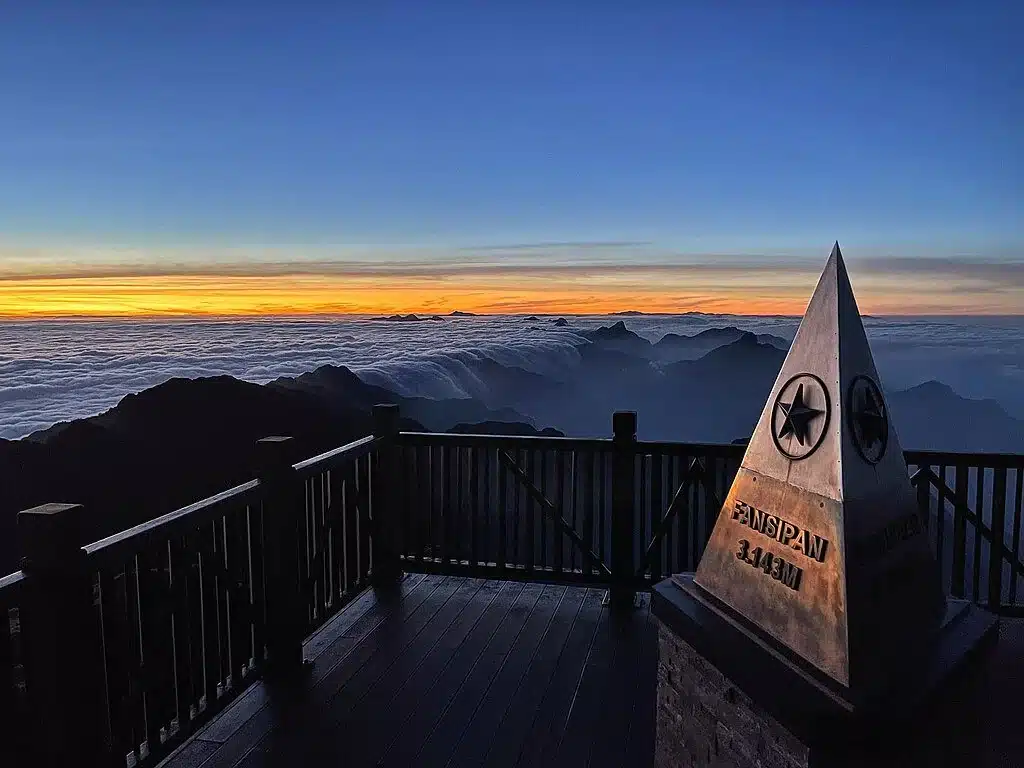
NKSTTSSHNVN, CC BY-SA 4.0, via Wikimedia Commons
Quick Hike Stats
| Location | Northern Vietnam |
| Distance | 7 miles (11.2 km) one-way |
| Difficulty | Hard |
| Duration | 5-7 hours |
| Best Time to Visit | March to April, September to November |
Mount Fansipan isn’t just a hike—it’s an epic journey to the highest peak in Indochina. Known as the “Roof of Indochina,” this mountain offers adventurers a breathtaking trek through diverse landscapes that will challenge and inspire you.
What Makes Mount Fansipan Special
As you ascend, you’ll witness a dramatic transformation of terrain. The journey begins in lush bamboo forests and gradually transitions to rocky, exposed trails. Hikers navigate a mix of stairs and ladders, adding an element of adventure to the challenging climb.
Flexible Hiking Options
Worried about the full trek? Fansipan has you covered:
- Hike Up, Cable Car Down: Conquer the summit on foot, then enjoy a scenic cable car descent. It’s the perfect compromise for those wanting the achievement without the full return hike.
Summit Experience
Reaching the peak is more than just a physical achievement– it’s a moment of pure magic. Panoramic views stretch across the Hoàng Liên Sơn mountain range, revealing terraced rice fields and verdant valleys that seem to touch the horizon.
2. Mount Bromo, Indonesia: Sunrise Over a Volcanic Wonderland
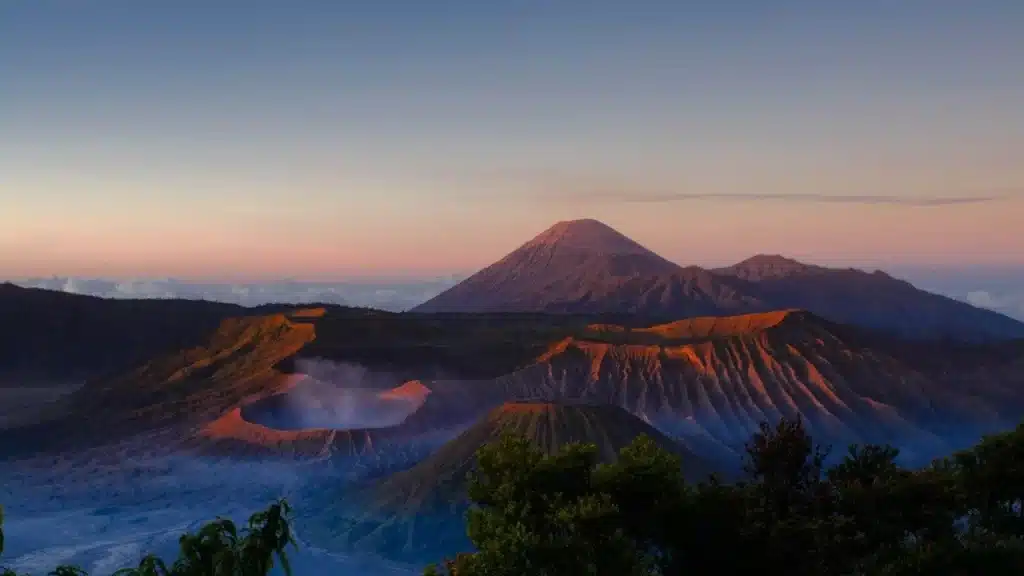
Quick Hike Stats
| Location | East Java, Indonesia |
| Terrain | Volcanic landscape |
| Distance | 10 km round-trip |
| Difficulty | Moderate |
| Duration | 5-7 hours |
| Best Time to Visit | April to October |
Mount Bromo isn’t just a hike—it’s a journey into an alien landscape that feels more like another planet than Earth.
The Legendary Sunrise Trek
The magic of Mount Bromo happens before the sun fully rises. Visitors typically:
- Take a jeep ride from Cemoro Lawang village
- Climb to a strategic viewpoint
- Watch the sunrise illuminate the volcanic landscape
Crater Exploration
After sunrise, adventurers can:
- Walk across the “sea of sand”
- Climb 250 steps to the crater’s edge
- Get an up-close view of the smoking volcanic crater
Why Mount Bromo is Unmissable
- Surreal, otherworldly volcanic landscape
- Incredible photography opportunities
- Unique combination of natural beauty and geological wonder
3. Kawah Ijen, Indonesia: The Midnight Volcanic Spectacle
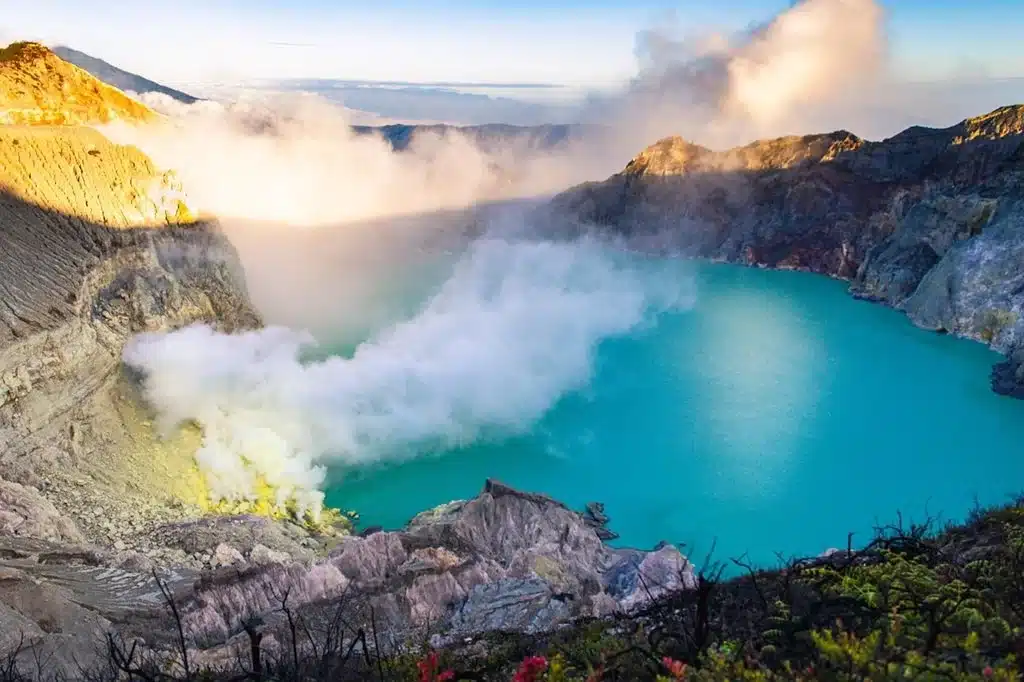
Quick Hike Stats
| Location | East Java, Indonesia |
| Terrain | Active Volcanic Crater |
| Distance | 6 km round-trip |
| Difficulty | Moderate to Hard |
| Duration | 5-7 hours |
| Best Time to Visit | May to September |
Kawah Ijen is not just a hike—it’s a surreal midnight adventure that defies imagination. This extraordinary volcanic trek offers something no other hike in Southeast Asia can: mesmerizing blue flames dancing in the darkness.
The Blue Flame Experience
The magic of Kawah Ijen happens in the dead of night. This unique hike is all about:
- Witnessing rare blue flames caused by burning sulfuric gases
- Exploring an active volcanic crater
- Experiencing a truly otherworldly landscape
Midnight Trek Essentials
- Start time: 1-2 AM
- Duration: Approximately 3 hours to summit
- Must-bring:
- Protective mask (for sulfur fumes)
- Sturdy hiking boots
- Warm layers
- Headlamp
Crater Lake and Sulfur Mining
Beyond the blue flames, Kawah Ijen offers:
- A stunning turquoise acidic crater lake
- Glimpse into local sulfur mining operations
- Breathtaking views of a volcanic landscape like no other
4. Dragon Crest Viewpoint (Tab Kak Hang Nak), Thailand: Krabi’s Hidden Hiking Gem
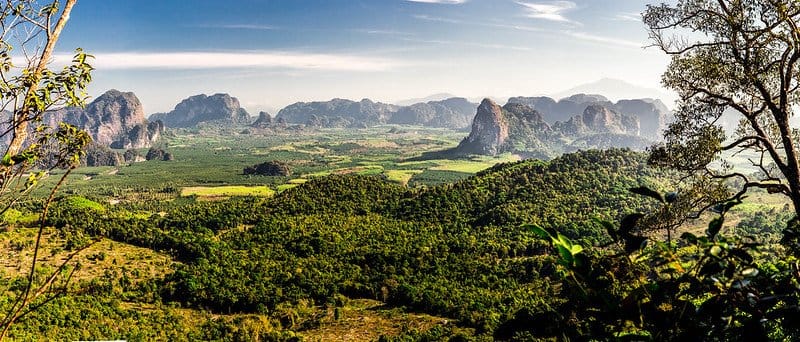
Fletcher Christian, Flicker
Quick Hike Stats
| Location | Krabi, Thailand |
| Terrain | Tropical Jungle to Coastal Viewpoint |
| Distance | 7-8 km round-trip |
| Difficulty | Moderate to Hard |
| Duration | x hours |
| Best Time to Visit | November to March |
The Dragon Crest trail is your ticket to the most spectacular view in Krabi—a panoramic vista that will take your breath away.
The Trail Experience
Your journey includes:
- Dense tropical forest hiking
- Rocky and muddy trail sections
- Gradual ascent with increasing challenge
- Summit at 565 meters above sea level
Viewpoint Highlights
- Sweeping views of Andaman Sea
- Limestone karst landscapes
- Panoramic shots of Railay Beach
- Views of distant islands like Phi Phi
Photography and Timing Tips
- Best times: Sunrise or sunset
- Bring:
- Extra water
- Sturdy hiking shoes
- Camera with wide-angle lens
- Light, breathable clothing
5. Doi Inthanon National Park, Thailand: Thailand’s Rooftop Adventure
Quick Hike Stats
| Location | Northern Thailand |
| Elevation | 2,565 meters |
| Distance | 2.5–7 km |
| Difficulty | Easy to Moderate |
| Duration | 5-7 hours |
| Best Time to Visit | November to February |
Doi Inthanon isn’t just a hike—it’s a journey to the roof of Thailand, where misty mountains, diverse ecosystems, and cultural wonders converge.
Trail Options for Every Adventurer
Kew Mae Pan Nature Trail
- Length: 2.5 km
- Highlights:
- Panoramic valley views
- Morning mist landscapes
- Perfect for shorter hikes
Ang Ka Nature Trail
- Focus: Mossy forest exploration
- Experience:
- Close encounter with unique flora
- Wildlife spotting opportunities
- Immersive forest environment
Cultural Highlights
Beyond natural beauty, Doi Inthanon offers:
- Royal pagodas honoring the king and queen
- Peaceful mountain gardens
- Blend of natural and cultural experiences
6. Mount Pinatubo, Philippines: A Volcanic Rebirth Journey
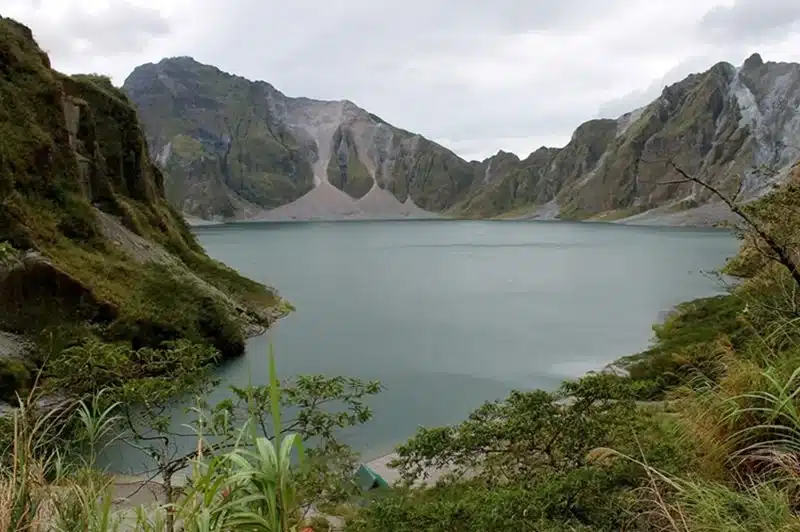
Quick Hike Stats
| Location | Luzon, Philippines |
| Terrain | Volcanic landscape |
| Distance | ~11 km round-trip |
| Difficulty | Easy to Moderate |
| Duration | 4-6 hours |
| Best Time to Visit | November to May |
Mount Pinatubo tells a story of destruction and incredible natural renewal—a testament to the raw power of our planet.
The Epic Adventure Begins
4×4 Desert Crossing
- Thrilling ride through lahar landscapes
- 30-45 minute journey
- Unique geological exploration
Crater Lake Trek
- Trail Length: 5.5 km
- Hiking Time: 1.5-2 hours
- Summit Reward: Breathtaking turquoise crater lake
Landscape Transformation
- Witness the aftermath of the 1991 eruption
- Explore a dramatically reshaped volcanic terrain
- Experience nature’s incredible resilience
7. Nong Khiaw Viewpoint, Laos: A Hidden Karst Kingdom
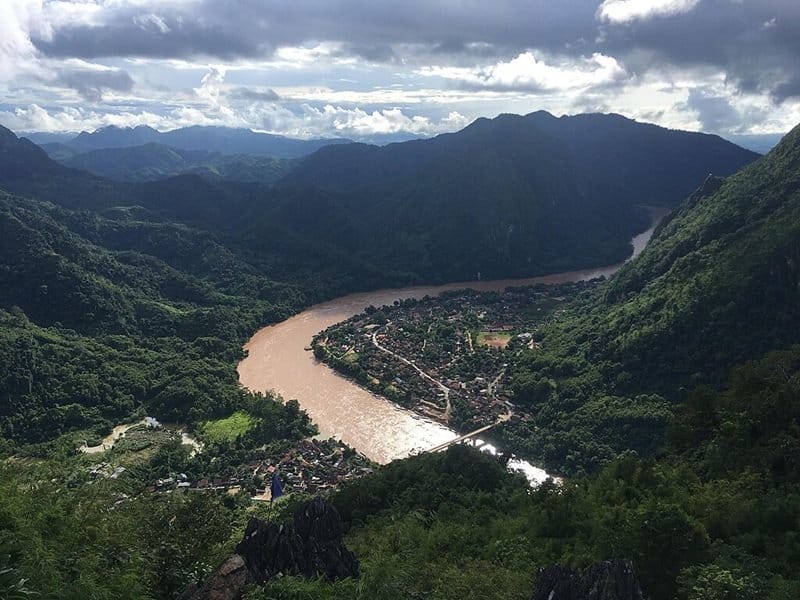
Christophe95, CC BY-SA 4.0 , via Wikimedia Commons
Quick Hike Stats
| Location | Northern Laos |
| Landscape | Karst Mountains and Nam Ou River |
| Distance | 3.5 km round-trip |
| Difficulty | Moderate |
| Duration | 3-4 hours |
| Best Time to Visit | November to February |
Nong Khiaw is more than a hike—it’s a journey into the heart of Laos’s most breathtaking landscape, where limestone peaks and river valleys create a natural masterpiece.
The Trail Experience
Hiking Highlights
- Stunning karst mountain views
- Winding Nam Ou River panorama
- Off-the-beaten-path adventure
- Peaceful, less-crowded trail
Trail Conditions
- Duration: 1.5-2 hours to summit
- Terrain:
- Mixed dirt paths
- Some steep sections
- Rocky and uneven areas
8. Yeak Laom Lake Trail, Cambodia: A Volcanic Crater Sanctuary
Quick Hike Stats
| Location | Ratanakiri, Cambodia |
| Terrain | Karst MountaiVolcanic Crater Lake |
| Distance | 3 km lake loop |
| Difficulty | Easy to Moderate |
| Duration | 1-1.5 hours |
| Best Time to Visit | November to February |
Yeak Laom Lake offers a rare glimpse into Cambodia’s hidden natural wonders—a pristine volcanic crater lake surrounded by untouched jungle.
Trail and Lake Highlights
- Crystal-clear volcanic crater lake
- Dense tropical forest
- Swimming opportunities
- Cultural significance for local indigenous people
Trail Details
- Loop Duration: 1-1.5 hours
- Terrain:
- Mostly flat
- Some uneven sections
- Tropical forest setting
Cultural and Natural Significance
- Sacred site for Tampuan indigenous people
- Pristine natural environment
- Opportunity for cultural learning
- Peaceful, less-touristy destination
Swim and Relax
- Safe swimming available
- Refreshing, clear water
- Perfect post-hike cooling spot
9. Mount Zwegabin, Myanmar: A Spiritual Peak Among Karst Mountains
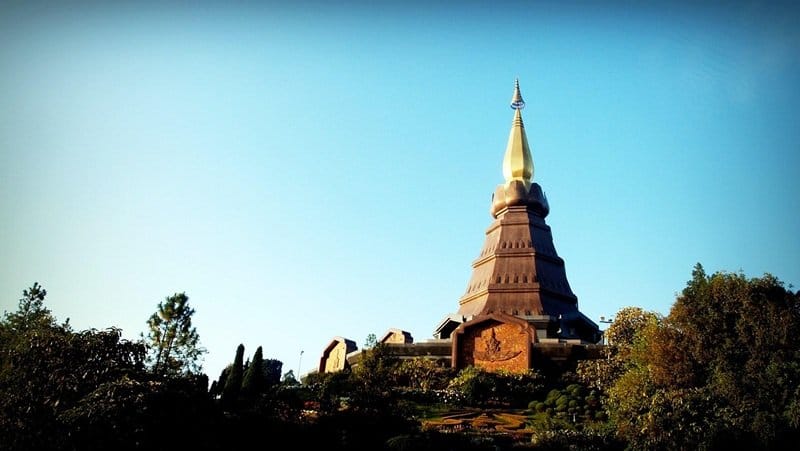
Quick Hike Stats
| Location | Hpa-An, Kayin State, Myanmar |
| Elevation | 722 meters |
| Distance | ~7 km round-trip |
| Difficulty | Hard |
| Duration | 4-6 hours |
| Best Time to Visit | November to February |
Mount Zwegabin is more than a hike—it’s a spiritual journey through Myanmar’s most breathtaking landscape, where ancient stone steps meet panoramic views and cultural significance.
The Ascent: A Cultural Mountain Experience
Trail Highlights
- Steep stone step trail
- Forested mountain terrain
- Buddhist pagoda at the summit
- Panoramic karst mountain views
Journey to the Top
- Duration: 2-3 hours
- Terrain:
- Predominantly stone steps
- Steep sections
- Occasional countryside glimpses
Spiritual Significance
- Important Buddhist pilgrimage site
- Monks and pilgrims often on the trail
- Peaceful, reflective atmosphere
Summit Experience
- Stunning views of Hpa-An region
- Rice fields and local villages below
- Golden-hour lighting at sunrise/sunset
- Serene pagoda at the peak
10. Mount Pulag, Philippines: Hiking Above the Clouds
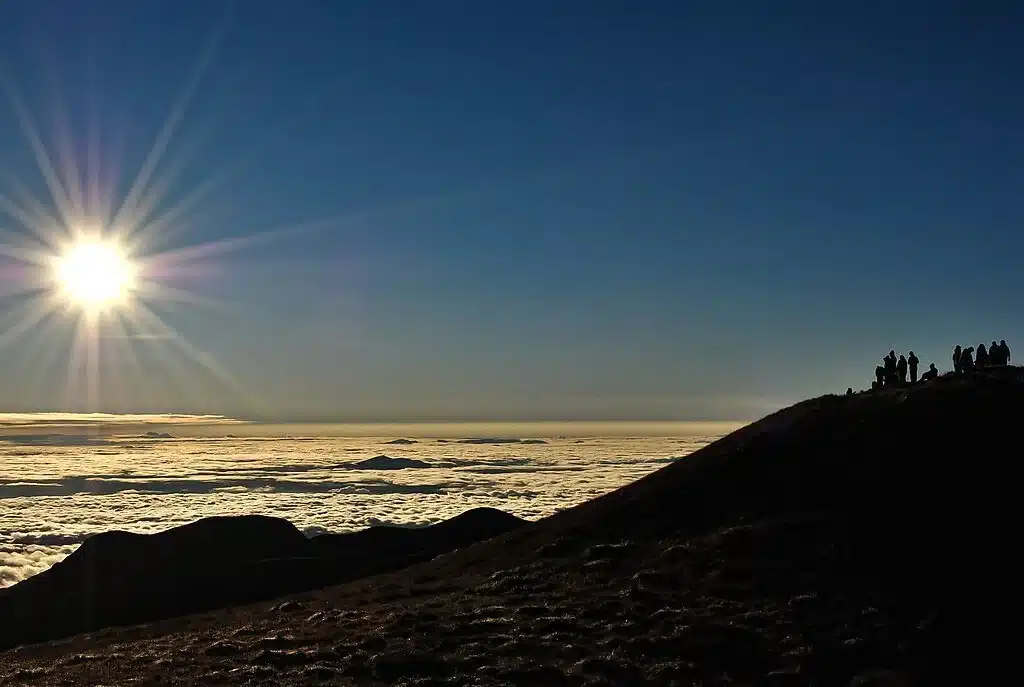
Kalithecat00, CC BY-SA 4.0, via Wikimedia Commons
Quick Hike Stats
| Location | Cordillera Mountains, Luzon, Philippines |
| Elevation | 1,460 feet (476 m) |
| Distance | ~10 miles (16 kms) round-trip |
| Difficulty | Moderate |
| Duration | 6 to 8 hours (Ambangeg Trail) |
| Best Time to Visit | November to April |
Mount Pulag offers a once-in-a-lifetime experience—hiking above a sea of clouds in the Philippines’ most magical mountain landscape.
Trail Options
Ambangeg Trail (Recommended for Beginners)
- Easiest route
- Suitable for first-time hikers
- Passes through diverse landscapes
Landscape Diversity
- Pine forests
- Highland grasslands
- Changing ecological zones
- Stunning mountain vistas
The Famous Sea of Clouds
- Sunrise phenomenon
- Clouds flowing like an ocean
- Mountain peaks rising above cloud cover
- Breathtaking photographic opportunities
Hiking Flexibility
- Can be done as:
- Single-day predawn hike
- Overnight trek
- Requires early morning start
- Permit required at Ranger Station
Bonus Day Hike: Dragon’s Back Trail – Hong Kong’s Urban Nature Escape
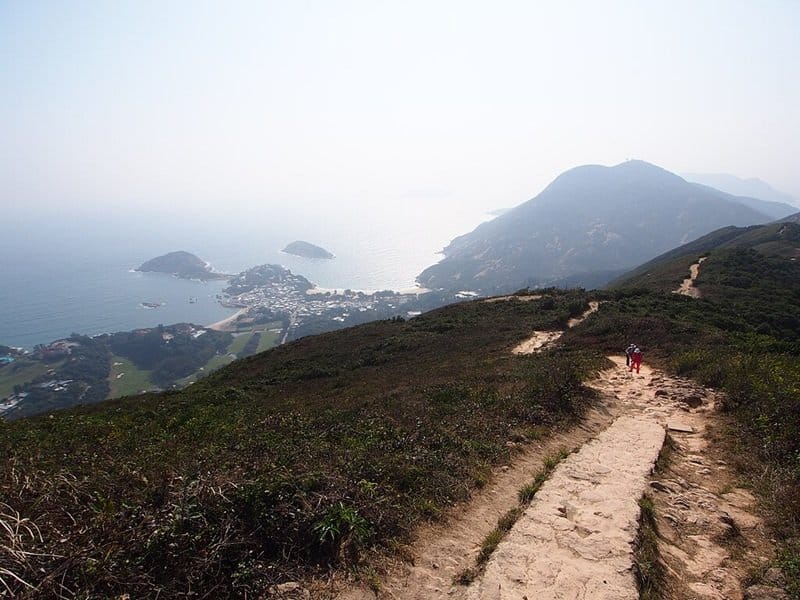
rheins, CC BY 3.0 , via Wikimedia Commons
Quick Trail Facts
| Location | Hong Kong |
| Distance | 8.5 kilometers (round-trip) |
| Difficulty | Easy to Moderate |
| Duration | 3-4 hours |
| Best Time to Visit | October to March |
Pro Tip: Dragon’s Back might not be in Southeast Asia proper, but it’s a perfect addition for travelers exploring the region. Its proximity and accessibility make it an unmissable adventure!
Why Dragon’s Back is a Must-Hike Trail
Imagine a hiking trail that offers the perfect blend of urban convenience and breathtaking natural scenery. The Dragon’s Back Trail isn’t just a hike—it’s an experience that defies expectations. Located just a stone’s throw from Hong Kong’s bustling city center, this trail winds along a dramatic coastal ridge that will take your breath away.
Stunning Panoramic Views
As you climb the well-maintained path, you’ll be treated to panoramic vistas that seem almost too good to be true. Gaze out over:
- Shek O Beach
- Tai Long Wan
- Surrounding islands
- The sparkling South China Sea
Trail Highlights
- Accessibility: Easily reached via public transportation from Shau Kei Wan
- Terrain: Gentle ascent with undulating hills and rocky outcrops
- Scenery: Coastal ridge with uninterrupted views
- Difficulty: Perfect for hikers of all skill levels
Practical Tips for Hiking Dragon’s Back
- Getting There: Take public transport to Shau Kei Wan MTR station
- What to Bring:
- Comfortable hiking shoes
- Water and snacks
- Sun protection
- Camera (trust us, you’ll want to capture these views!)
- Best Time to Hike: Early morning or late afternoon to avoid midday heat
The Urban Nature Escape
What makes Dragon’s Back truly special is its unique positioning. Where else can you start your day in a metropolitan center and within hours be walking along a stunning coastal ridge, surrounded by nothing but natural beauty? It’s the ultimate escape for travelers who want to experience both urban excitement and natural tranquility.
End of Trail Reward
Your hike concludes at the peaceful Tai Long Wan beach—the perfect spot to rest, reflect, and soak in the incredible journey you’ve just completed.
Planning Your Day Hiking in Southeast Asia
Best Seasons for Hiking
- Dry Season: Typically November to February
- Avoid: Monsoon months (June to October)
Essential Hiking Preparation
- Check local weather conditions
- Carry sufficient water and snacks
- Wear appropriate hiking gear
- Consider local guide services
For more detailed tips on the essential gear and preparations for your day hike, check out this article on Day Hike Essentials.
Handling Tropical Weather Conditions
- Start hikes early to avoid peak heat
- Use electrolyte supplements
- Take frequent short breaks
- Monitor personal energy levels
- Be prepared for rapid weather changes
Stay Safe
- Inform someone of your hiking plans
- Carry basic first aid kit
- Check trail conditions beforehand
- Stay hydrated and pace yourself
Sustainability and Responsible Hiking
Let’s be real: as hikers and nature lovers, we’re not just visitors—we’re guardians of these incredible landscapes. Protecting these stunning environments is part of the adventure. Here’s how we can make a difference:
- Stay on marked trails
- Carry out all trash
- Respect local wildlife and communities
- Follow the “Leave No Trace” principles
Final Thoughts
Southeast Asia’s hiking trails offer more than just a walk—they’re a gateway to understanding the region’s incredible natural beauty, diverse landscapes, and cultural richness. Whether you’re a seasoned hiker or a curious traveler, these day hikes promise memories that will last a lifetime.
Ready to Hit the Trails?
Start planning your hiking adventure today. Pack your gear, embrace the adventure, and get ready to explore the breathtaking trails of Southeast Asia!
Disclaimer: Always check current local conditions, trail status, and potential travel restrictions before planning your hike.
FAQs About Day Hikes in Southeast Asia
Q1: What is the Best Season for Hiking in Southeast Asia?
The best hiking season in Southeast Asia is during the dry months, typically from November to February. During this period, you’ll experience:
- Lower humidity
- Minimal rainfall
- More comfortable temperatures
- Clearer trail conditions
- Better visibility for scenic views
Q2: How Difficult Are Day Hikes in Southeast Asia?
Difficulty varies widely, but most popular day hikes range from easy to moderate. Factors affecting difficulty include:
- Trail terrain
- Elevation gain
- Local climate
- Individual fitness level
Most trails offer options for beginners and experienced hikers alike, with well-marked paths and varying difficulty levels.
Q3: What Should I Pack for a Day Hike in Southeast Asia?
Essential packing list includes:
- Lightweight, moisture-wicking clothing
- Hiking boots or trail shoes
- Plenty of water
- High-SPF sunscreen
- Insect repellent
- Small first-aid kit
- Lightweight rain jacket
- Energy snacks
- Hat and sunglasses
Q4: Are Day Hikes in Southeast Asia Safe?
Generally, yes. To ensure safety:
- Hike with a buddy or guided group
- Inform someone of your hiking plans
- Check local weather conditions
- Carry a fully charged phone
- Stay on marked trails
- Bring sufficient water and supplies
Q5: Do I Need Special Permits for Hiking?
Permit requirements vary by country and specific trail. Some tips:
- Research local regulations before your trip
- Some national parks require entrance fees
- Popular trails might need advance booking
- Always carry identification and necessary documents
Q6: What Wildlife Might I Encounter?
Southeast Asian trails can feature:
- Various bird species
- Small mammals
- Occasional reptiles
- Tropical insects
Important: Maintain a safe distance, do not feed wildlife, and follow local guidelines for wildlife interactions.
Q7: How Much Does a Day Hike Cost?
Costs can range from:
- Free (public trails)
- $5-$20 for national park entrance fees
- $50-$100 for guided hiking tours
- Additional costs for transportation and equipment rental
Q8: What Fitness Level is Required?
Most day hikes are suitable for:
- Moderately fit individuals
- Average recreational hikers
- People with basic cardiovascular endurance
Recommended preparation:
- Regular walking or light cardio
- Strength training
- Stretching
- Gradual hiking practice before the trip
Q9: How Do I Prepare for Hiking in Tropical Climates?
Tropical hiking preparation tips:
- Acclimatize to humidity
- Stay hydrated
- Use electrolyte supplements
- Wear lightweight, breathable clothing
- Start hikes early morning or late afternoon
- Take frequent breaks
- Listen to your body
Q10: Are Guided Hikes Recommended?
Pros of guided hikes:
- Local expert knowledge
- Increased safety
- Cultural insights
- Navigation assistance
- Equipment support
Cons:
- Higher cost
- Less flexibility
- Preset pace
Recommendation: Consider guided hikes for first-time visitors or challenging trails.


